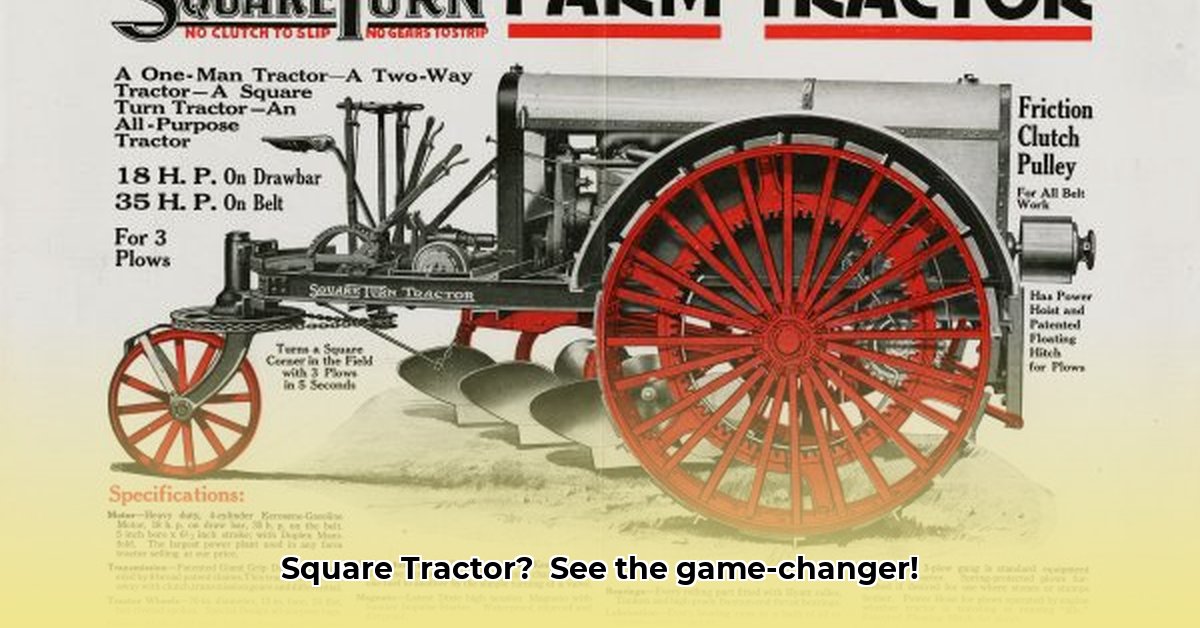
The Square Turn tractor, a largely forgotten marvel of early 20th-century engineering, offers a compelling case study in agricultural innovation, market forces, and the challenges of bringing a groundbreaking technology to fruition. Its unique design, centered around a revolutionary transmission system, promised to reshape farming practices, but its story is one of both remarkable ingenuity and ultimately, heartbreaking failure. For another example of early agricultural innovation, see this 1948 Ford Tractor page.
The Square Turn's Revolutionary Design: A Giant Grip on the Future?
Unlike the cumbersome turns of its contemporaries, the Square Turn boasted a patented "giant grip drive" transmission. This allowed for near-instantaneous 90-degree turns, a significant advantage in efficiency, especially when working in tight spaces or around obstacles. Powered by a robust 510 cubic inch Climax 4-cylinder engine (producing approximately 35 horsepower, and 18 horsepower on the drawbar), it was a powerful machine for its time, capable of handling tasks that previously required multiple teams of horses. This innovative design, combined with the promise of a remarkably short learning curve (advertised as only 10 minutes!), initially generated considerable excitement among potential buyers.
Was this revolutionary design enough to guarantee success? The answer, as we will see, is a complex one. Within its first year, the Square Turn Tractor Company, buoyed by investor confidence, sold 3,500 shares and aimed for an ambitious yearly production of 2,000 tractors. This initial success, however, was short-lived.
A Rise, a Fall, and Lessons Learned from Nebraska's Bold Experiment
The Square Turn's Nebraska origins and ambitious goals quickly met the harsh realities of the early 20th century. World War I dramatically impacted its production, creating severe shortages of vital materials like steel and skilled labor, forcing the company to refund deposits to prospective buyers and bring production to a grinding halt. Adding to this, the devastating agricultural depression of the 1920s delivered a further blow, crippling demand and leaving even this innovative machine vulnerable to the economic downturn. The Square Turn's story serves as a powerful illustration that even the most brilliant inventions are often at the mercy of larger, uncontrollable forces.
Did the Square Turn’s innovative design fully compensate for these economic realities? The answer is definitively no. While the “giant grip drive” offered significant advantages in maneuverability and reduced labor, the economic headwinds proved insurmountable.
An Enduring Legacy of Ingenuity: More Than Just a Failed Venture
Despite its relatively short lifespan, the Square Turn’s influence endures. Its innovative "giant grip drive" transmission remains a testament to the ingenuity of its creators. Agricultural engineers continue to explore whether similar concepts could yield benefits in modern agricultural equipment, highlighting a renewed interest in the Square Turn's design. Its powerful engine, too, showcases the impressive engineering prowess available at the time. Even the company's strategic missteps provide valuable insights for today's agricultural technology developers and investors. The Square Turn’s story raises a critical question: What can we learn from the successes and failures of this bold early 20th-century agricultural innovation?
Unanswered Questions and the Ongoing Pursuit of Historical Accuracy
While significant information exists about the Square Turn tractor, some key details remain elusive. Precise production and sales figures are difficult to pin down, and a comprehensive analysis of user feedback and direct performance comparisons with contemporary tractors is still missing. This lack of readily available data makes a complete assessment of its overall impact on agricultural practices challenging. Further research into its production records, user manuals, and contemporary news articles is crucial to fully understand the Square Turn's place in agricultural history. This presents a compelling opportunity for future scholarly work.
The Square Turn's Practical Applications Today: A Case Study for the Modern World
The historical significance of the Square Turn tractor extends beyond a simple narrative of success or failure. Its story offers valuable lessons across multiple disciplines. Agricultural historians benefit from further research into its history and impact, enhancing our collective understanding of early 20th-century farming. Museums can utilize the Square Turn's innovative design to create engaging exhibits, educating the public about agricultural technology’s evolution. Agricultural engineers may find inspiration in its unique transmission system, potentially leading to innovative designs for modern, sustainable equipment. And finally, today's investors in agricultural technology can learn valuable lessons about market timing, diversification, and the resilience of successful technology development from the Square Turn's ultimate failure.
Key Takeaways:
- The Square Turn’s unique “giant grip drive” transmission provided unparalleled maneuverability for its time.
- Initial market reception was strong, showcasing the potential of the innovative design.
- World War I and the subsequent agricultural depression greatly hampered production and demand, highlighting the importance of market stability for technological success.
- Despite its commercial failure, the Square Turn's legacy continues to inspire engineers and historians alike.